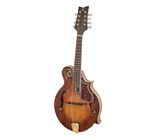It is not only that the factory setup is horrible, but certain parts on this mandolin do not fit together properly. The instrument looks good and the sound from the pickup-system is very good, but those are the only positives as is comes out of the box. The first one I received from Thomann was too badly assembled to make it worth an effort to try to fix it. The replacement was a little better.
Normally I would expect setup of a new mandolin to include nut sanding/filing, adjust the bridge-height with level wheels, a fresh set of strings and intonation. This one require a lot more. I spent some 20-25 hours modifying and setting it up. Expect a trained/professional luthier with a proper workshop/toolchest to charge for 4-6 hours of work:
1. Had to sand off a lot of wood from the base of the bridge to make the bridge low enough to be able to obtain the desired action height. About 3mm of wood was removed from the bridge-base on the treble-side and 2mm on the bass-side, as the bridge in its factory-configuration was a little tilted to one side. The sanding was done on a surface with the same curvature as the mandolins arched top. In addition to lowering the bridge this also increased the bridge's contact-surface against the spruce-top which gave the instrument more acoustic volume and sustain. The bridge is sanded down so much that it is less than 1mm left of the air-gap between the centre of the bridge and the body-top. Now the instrument tends towards slight fret buzz with the bridge in the lowest position and my setup has the level-wheels on the bridge raised about 1mm on each side.
2. The tailpiece was placed a little too much towards the bass side, and would with the strings under tension pull the bridge off its correct position. The first mandolin I received would have required the tailpiece to be moved about 3cm, but on this latest one I managed to get the bridge stable by moving the tailpiece only about 3mm. This means that the old factory-drilled holes for the tailpiece are not visible beside the tailpiece when the job is done. The original screw-holes were filled in with maple+glue and new ones drilled.
3. The pickup-system was not grounded to the tailpiece/strings resulting in a loud hum when the instrument is used in a configuration where it is not isolated from the amplification-system with a wireless link or a DI-box. I solved this problem by soldering a thin wire between the sleeve of the output-jack and the underside of the tailpiece. The instrument is built from what looks like aged wood, and there was a tiny wormhole in the spruce-top hidden under the tailpiece that i pulled this wire through after soldering it to the underside of the tailpiece. With no wormhole one would have to drill a hole for the wire.
4. Five of the frets were not seated properly. I knocked all frets into their correct position, then straightened the neck with the truss-rod and did some minor fret-levelling with a fret-levelling-file. Then the frets were re-dressed where required.
5. A couple nuts were added to the arm/bolt holding the pick-guard to prevent the pick-guard from falling off. These nuts must simply have been omitted at the factory.
6. Several screw-holes had been stripped and have had some fibres of wood added to make the wood-screws stay in place. My guess is that the factory has used a little too wide a drill-bit for the job. The preamp-box was almost falling out on its own when I first unpacked the mandolin. A small drop of liquid wax in each hole before putting the screws in does also help form better "threads" in the wood.
With all this, and a normal setup, the instrument plays well and sounds very good. These things would be done in minutes if the issues had been sorted in manufacturing where the workers should have much better facilities and tools available than most consumers. Just 10-15 more minutes per mandolin at the factory would have made a wold of difference. Ortega need to step up their QC.

